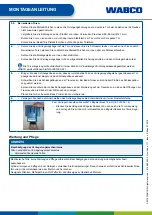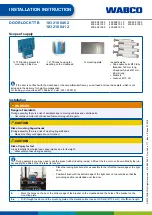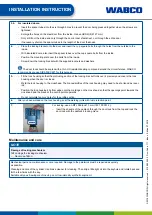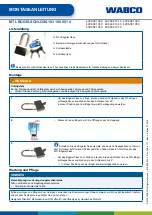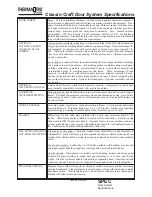
INSTALLATION INSTRUCTION
© 2018 W
ABCO
All rights reserved – 815 980 344 3 Doc-Code 1
11 Index Edition 07.2018
3.b
For insulated doors:
– Insert the spacer tubes into the six through bores to prevent the door being pressed together when the screws are
tightened.
– Enlarge the holes on the steel door from the inside. Use an HSS drill (Ø 21 mm).
– Only drill from the inside and only through the door’s inner steel sheet, not through the entire door.
– If necessary, shorten the spacer tubes to the length of the door thickness.
4.
– Place the locking bracket onto the door and insert the cup square bolts through the holes from the outside to the
inside.
– With insulated doors, also insert the spacer tubes over the cup square bolts from the inside.
– Position the mounting plate over the bolts from the inside.
– Screw down the locking bracket with the supplied locknuts and washers.
i
i
The door lock should be sealed with a thin, UV-resistant sealing compound around the circumference. WABCO
recommends you use SIKAFLEX 221 for this purpose.
5.
– Fit the lock housing so that the protruding section of the locking bracket folds over it precisely and covers the lock
housing when the door is closed.
–
Weld the lock housing to the crosshead. The braces/profiles of the lock housing may need to be shortened as requi
-
red.
– Position the lock housing’s bottom edge onto the markings on the crosshead so that the openings point towards the
crosshead and the brace at the centre points upwards.
–
Do not calculate too much play for the profile section.
6.
After you have welded on the lock housing, seal the welding joints with rust protection paint.
7.
For locking, use an MTL Padlock 13 mm (183 100 001 4).
– Insert the shackle of the padlock through the door lock from the top and lock the
door lock with the padlock’s locking piece.
Maintenance and care
NOTE
Damage of locking mechanism
Teflon clogs the locking mechanism.
–
Never use Teflon.
Mechanical parts: no maintenance or care required. Damage to the paintwork must be repaired as quickly
as possible.
Cleaning and care of the cylinder: Use brake cleaner for cleaning. Then drip a little light oil into the keyhole and rotate back and
forth a few times with the key.
Suitable oil types: Sewing machine oil, gun oil, low-viscosity synthetic engine oil.


